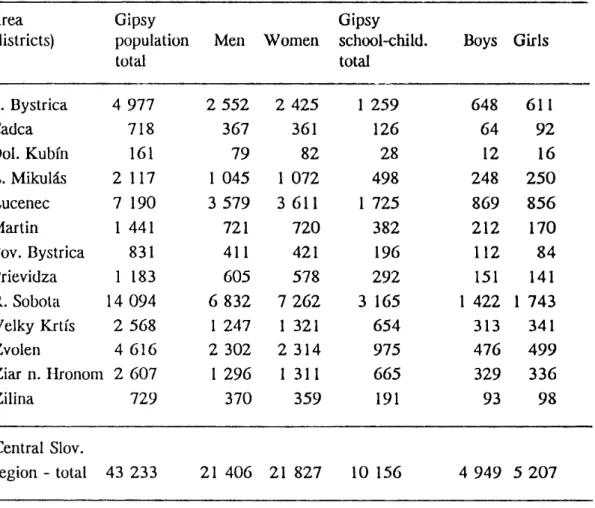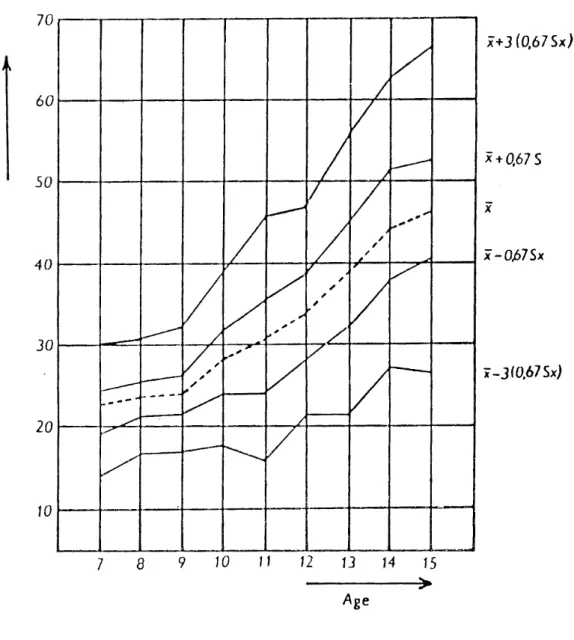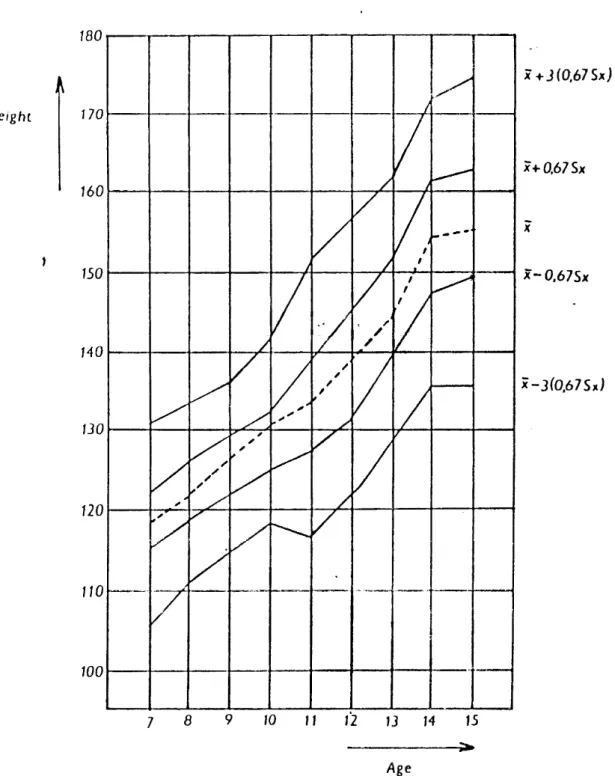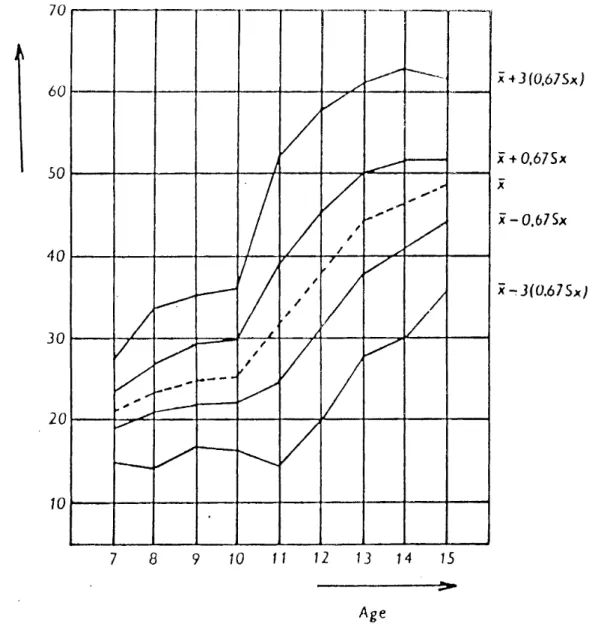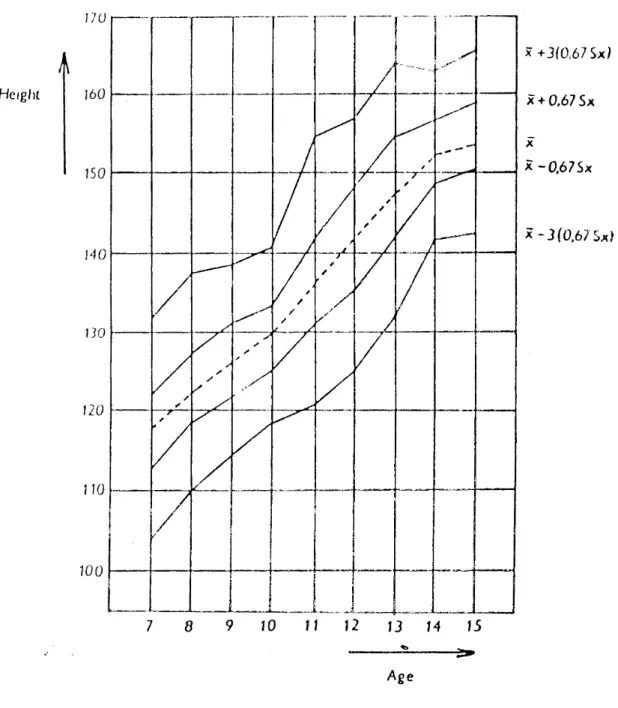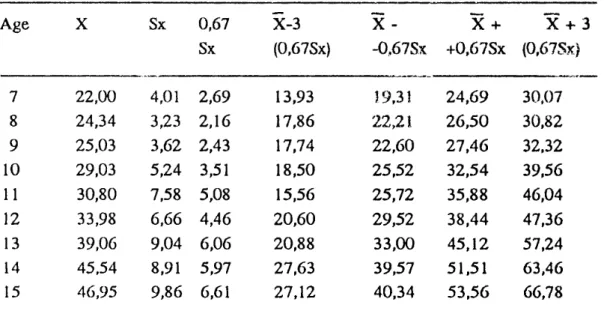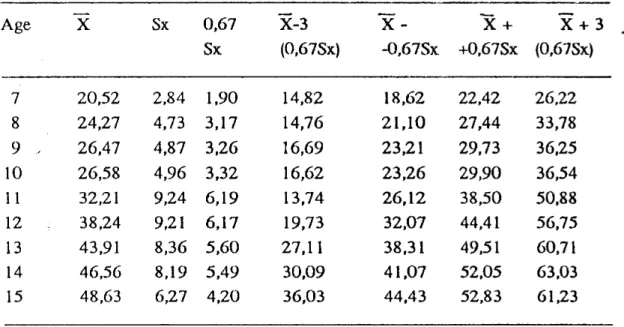KAROL LANGSTEIN
Dept. of Biology, Pedagogical Faculty, Banská Bystrica, Czechoslovakia
TYPE STANDARDS OF GIPSY SCHOOLCI11LDREN IN THE CENTRAL SLOVAKJAN REGION
REZÜMÉ: (Középszolvákiai iskolaköteles cigánygyerekek testmagasság és testtömeg standard értékei) A humánbiológia bizonyított tétele, hogy a gyermekek növekedése, érése az adott etnikum egyik jelentős mutatója. Vizsgálatunkban a 7—
15 éves cigánygyerekek két testméretével foglalkozunk. Reprezentatív mintánkat a középszlovákaiai terület járásaiból állítottuk össze. Méréseink eredményeit a statisztikai számítások alapján összeállított táblázatok, ábrák és görbék formájában prezentáljuk.
A középszlovákiai iskolaköteles cigánygyerekek testmagasság és testtömeg értékeit az adott életkorra elért normál-standard értékekben mutatjuk be.
The type standards for weight and height of Gipsy school-children in the Central Slovakian Region represent in their dependency upon the âge certain development means limited by intervais in the Standard zones.
The values we obtained may form the basis for further analysis or for the possible application.
When assessing the type standards for somatic development in Gipsy children living in the Central Slovakian region we took into account the vérification of the fundamental and generally established biological regularities in the human organism - especially the regularities in the growth and development of healthy children.
Our research was carried out on the observation of Gipsy school-children.
These children have in their development much better conditions then they had in the past. Gipsy population is not an original ethnie group of Slovakia, but tliis population makes up a numerous group of population. This ethnie group with its unique anthropological characteristic and rather différent economic and social development joins at present the production and social life in our country. This results in the graduai incorporation of this group into our society. But on the other hand, this ethnie group is fully conscious of its ethnie origin, anthropological
différent iation, of its own language, of its common features, of its way of life and of its cultural activity. ïhis social intégration graduaily changes into the assimilation and consolidation.
A half of the Gipsy population is represented by at the âge of 15. This high percentage of Gipsy youth signalizes the relevancy of solving this question on various levels. One of these levels was the investigation focused on the assessing the standard data in the somatic development and on the hody dispositions in the Gipsy youth. These data form the base for verifying and for setting out the principal and generaliy accepted biological regularities in human organism. In our research we concerned with the regularities of the growth and development in Gipsy children.
The share of Gipsy children in the total number of population in Slovak republic amount to 1. 1. 1978 about 3,9 % (189 989), out fo this, in the town of Bratislava it is 0,9 % (3207), in the West Slovakian region it is 2,6 % (42 621), in the Central Slovakian region it is 2,9 % (43 233), and in the Hast Slovakian région it amounts to 7,4 % (99 928).
The share of Gipsy school-children in total number of school-children indicates much more higher indices. The distribution of this share - as far as the whole Slovakia is concerned - amounts to 6,5 %, in the town of Bratislava it is 1,4
%, in the West Slovakian Region it is 4,3 %, in the Central Slovakian region it is 4,3 % and in Bast Slovakian region it is 11,8 %.
There are 46 627 Gipsy school-children at the âge of 6--15 living in the Slovak republic (23 234 boys and 23 393 girls)« The total number of Gipsy school- children amounts to 10 156 in the Central Slovakian region (4 949 boys and 5 207 girls.)
Within the frarne work of our research we examined 689 Gipsy children at the âge of 7—15. There are 330 girls and 359 boys examined in the course of our investigation. Our investigation was carried out at the beginning of 1978: in February, March and April.
Our research was carried out by the same team and possible errors appears to be quite negîigible.
Founded on the results of the Statistical characteristics we hâve calculated two body measurements for weight and for height These measurements have been taken also individually, i. e. we have calculated the standard indices for weight and height in individuals. We have assessed the relation of these îndividuals to our survey, The values of standard indices may serve not only for the reciprocal comparison of interacting signs, but they may also serve for expressing the proportionality in individuals.
9 6
Table 1. Distribution of Gipsy population in the Central Slovakian region according to districts
Area Gipsy Gipsy
(districts) population Men Women school-child. Boys Girls
total total
B. Bystrica 4 977 2 552 2 425 1 259 648 611
Cadca 718 367 361 126 64 92
Dol. Kubin 161 79 82 28 12 16
L. Mikulás 2 117 1 045 1 072 498 248 250
Lucenec 7 190 3 579 3 611 1 725 869 856
Martin 1 441 721 720 382 212 170
Pov. Bystrica 831 411 421 196 112 84
Prievidza 1 183 605 578 292 151 141
R. Sobota 14 094 6 832 7 262 3 165 1 422 1 743
Velky Krtfs 2 568 1 247 1 321 654 313 341
Zvolen 4 616 2 302 2 314 975 476 499
Ziar n. IIronom 2 607 1 296 1 311 665 329 336
Zilina 729 370 359 191 93 98
Central Slov.
region - total 43 233 21 406 21 827 10 156 4 949 5 207
To facilitate the analysis and for its possible application as well as for practical use of our results we have attained from our anthropological research we liave worked out so called standard type zones for weight and height. We have calculated these standards in the dependence upon the âge.
In order to correct the relative large scale of the span variability in the individual âge catégories we have used two-thirds values of the conclusive déviation (0,67 Sx). This déviation helped us in delimitating individual inean zones.
For better illustration we have tabulated and presented in figures the developing curve in the type standard zones. Also the cross-sectional type standards were drawn up. We should like to point to the known fact that the growth culmination, especially in adolescent children is inostly characterized by its high individual variability. Consequently, it may come about that the prématuré growing up children in the controlled population may reach the upper extreme zone, and on
the contrary the children showing certain signs of retardation in their development may remain deeply below the average. As far as this phenomenon appears to be of a transient character the individual in the course of one or two years may reach the normal mean zone. If this normal zone has not been reached by the individual the deep analysis shows to be necessary.
To delimitate the type standard zones we have elaborated tables for weight and for height respectively. These anthropological data were tabulated separately for boys and for girls. They were at the age of 7—15 (Table 2—5). With each mean value for weight and height respectively we have set out measures for conclusive déviation and the interval limited by X ± 0,67 Sx. This interval according to our calculation represents at the significance level p=0,01 normal values and the interval limited by X ± 3 (0,67 Sx) represents critical values.
Type Standard zones for weight and height were assessed in the dependence upon the age. These zones represent specific developing means limited by above mentioned intervais. The interval limited by 2/3 déviation includes the zone indicating the values of individuals showing a normal development of weight and height respectively. The next zone limited by X + 3 (0,67 Sx) includes the below the average values, as well as the above the average values of individuals. These values are limited by extreme values in individual age catégories.
On the basis of the results we obtained in the course of our investigation we have elaborated the type standard zones. These standard zones have been worked out in the relation to the weight and to the height of the children. This relation is has been presented in the form of developing curves (Figures 1—4).
Founded on the results of our analvsis wi have postulated and set out the standards for somatic development of Gipsy school-children living in the area of the Central Slovakian region. We have come to the conclusion that the Gipsy school-children of today attain certain heights and weights sooner than did those of the same age 20 years ago. This phenomena may be ascribed to the phenomena of accélération or it may be just a discontinuance of earlier retardation reflecting the conditions prevailLng in times subsequent to World War II. Consequently, the generál improvement in the factors of environment and better nutrition the Gipsy school-children are given in our socialist country has found expression in the higher values of height and weight, as well as in more rapid growth and development of these children.
>
Age
Figure 1. Crocc-sectional type zones for Weight according to the âge - boys
Heigh t
180
170
160
150
M O
130
120
110
100
/
/ / / /
(/ /i/ - - - -/ / / ///
Á
/t/ / / //
S/
S/
r • '
•
/ /
/*X J
/
/ 'x +3 (0,67 Sx)
x+0.67 Sx
ff-0.67S*
X - 3 Í O , 6 7 S x )
7 fl 9 10 11 12 13 14 15
Figure 2. Cross-sectiona! type zones for Height according to the âge - boys
Figure 3. Cross-sectionai type zones for Weight accordint to the âge - girls
When assessing the type standards for somatic development we took into account the vérification of the principal a generally established biological regularities in the human organism, especially the regularities in the growth and development in healthy children.
l o i
Hei ghl
7 a 9 10 11 12 13 H J5
"S»
Age
Figure 4. Cross-sectional type zones for Ileight aecording to the âge - girls
Table 2.Standard Zone for Weight according to the Age - Boys
Age X Sx 0,67 X-3 X - X + X
Sx (0,67Sx) -0.67SX +0,67Sx (0,67S
7 22,00 4,01 2,69 13,93 19,31 24,69 30,07
8 24,34 3,23 2,16 17,86 22,21 26,50 30,82
9 25,03 3,62 2,43 17,74 22,60 27,46 32,32
10 29,03 5,24 3,51 18,50 25,52 32,54 39,56
11 30,80 7,58 5,08 15,56 25,72 35,88 46,04
12 33,98 6,66 4,46 20,60 29,52 38,44 47,36
13 39,06 9,04 6,06 20,88 33,00 45,12 57,24
14 45,54 8,91 5,97 27,63 39,57 51,51 63,46
15 46,95 9,86 6,61 27,12 40,34 53,56 66,78
Table 3. Standard Zone for Height according to the Age - Boys
Age X Sx 0,67 X-3 X - X + X + 3
Sx (0,67Sx) -0,67Sx +0,67Sx (0,67Sx)
7 117,33 6,85 4,59 103,56 112,74 i 21 131,10
8 122,59 5,62 3,77 111,28 118,82 128,36 133,90
9 126,07 5,48 3,67 115,06 122,40 129,74 137,08
10 130,07 5,73 3,84 118,55 126,23 133,91 141,59
11 134,03 8,35 5,59 117,26 128,44 139,62 150,80
12 139,39 8,68 5,82 121,93 133,57 145,21 156,85
13 145,78 8,30 5,56 129,10 140,22 151,34 162,46
14 155,07 9,19 6,16 136,59 148,91 161,23 173,55
15 156,83 9,90 6,63 136,94 150,20 163,46 176,72
Table 4.Standard Zone for Weight according to the Age - Girls
Age X Sx 0,67 X-3 X - X + X + 3
Sx (0,67Sx) -0,67Sx +0,67Sx (0,67Sx)
7 20,52 2,84 1,90 14,82 18,62 22,42 26,22
8 24,27 4,73 3,17 14,76 21,10 27,44 33,78
9 26,47 4,87 3,26 16,69 23,21 29,73 36,25
10 26,58 4,96 3,32 16,62 23,26 29,90 36,54
11 32,21 9,24 6,19 13,74 26,12 38,50 50,88
12 38,24 9,21 6,17 19,73 32,07 44,41 56,75
13 43,91 8,36 5,60 27,11 38,31 49,51 60,71
14 46,56 8,19 5,49 30,09 41,07 52,05 63,03
15 48,63 6,27 4,20 36,03 44,43 52,83 61,23
Table 5. Standard Zone for Height according to tha Age - Girls
Age X Sx 0,67 X-3 X - X + X + 3
Sx (0,67Sx) ~0,67Sx +0,67Sx (0,67Sx)
7 116,65 7,03 4,71 102,52 111,94 121,36 130,78
8 123,37 6,84 4,58 109,63 118,79 127,96 137,11
9 126,50 6,09 4,08 114,26 130,58 138,74
10 129,33 5,57 3,73 118,14 125,60 133,06 140,52
11 136,66 8,13 5,45 12031 131,21 142,11 156,01
12 142,32 8,28 5,55 125,67 136,77 147,87 158,97
13 148,92 8,22 5,51 132,39 143,41 154,43 165,45
14 152,76 5,32 3,56 142,08 149,20 156,32 163,44
15 154,67 6,19 4,15 1 4?mL 150,52 158,82 167,12
IRODALOM
Dokládal, M.: Vysledky somatologického vyzkumu brenskych eikánskych detí skolního veku v reco 1967, Scripta medica 47, 3 : 211—215, 1974.
Eiben. O.: Budapesti óvodások és iskolások testi fejlettsége, KÖJÁL, Budapest, 1971.
Eiben. O. — Pásztor, E.: Adatok a magyar ifjúság biológiai fejlődéséhez, AnÜirop, Közi. 29 ; 45-72. Budapest, 1985.
Malá, H.: Soucasny stav antropologického vyzkumu cikánskych detí v Ceskoslovensku. CS. Pediater, 32, 1977. c. 9.
